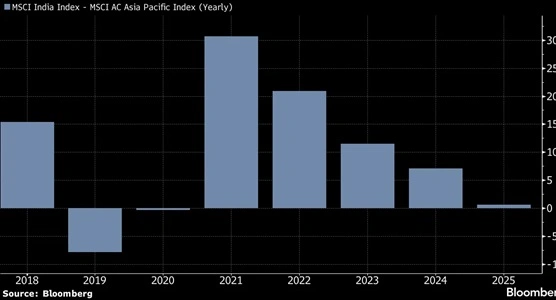India’s equity markets have been on a downward spiral, with a massive $556 billion wiped off the stock market’s valuation as concerns over economic growth and inflation intensify. The sell-off has rattled investor confidence, with major indices such as the Nifty 50 and the Sensex registering steep declines. The rout reflects growing fears about the economic outlook, both domestically and globally, as investors brace for tighter monetary policies and sluggish growth.
The Numbers Behind the Decline

The benchmark indices have shed significant value in recent weeks, with foreign institutional investors (FIIs) pulling out large sums from Indian equities. The Nifty 50 fell by nearly 3% in the past week alone, while the Sensex saw a similar decline, with market capitalization eroding across sectors such as technology, banking, and consumer goods.
Key data points reveal the extent of the rout:
- The combined market capitalization of companies listed on the Bombay Stock Exchange (BSE) has fallen by ₹46 lakh crore, equivalent to approximately $556 billion.
- FIIs, who had been net buyers earlier in 2024, turned sellers in December and January, offloading shares worth ₹25,000 crore in the past month.
Factors Driving the Sell-Off
- Inflation Concerns: Rising inflation, driven by elevated food and energy prices, has dampened investor sentiment. While the Reserve Bank of India (RBI) has maintained a balanced stance, concerns over potential rate hikes persist as inflation remains above the comfort zone.
- Global Slowdown: Fears of a global economic slowdown, exacerbated by monetary tightening in advanced economies, have weighed heavily on emerging markets like India. Slowing demand in key markets such as the US and Europe has raised concerns about export growth.
- Earnings Pressure: Corporate earnings in sectors such as IT and FMCG have come under pressure due to higher input costs and weak global demand. Market analysts have downgraded earnings expectations for several blue-chip companies.
- Rupee Volatility: The Indian rupee has experienced fluctuations against the US dollar, adding to investor uncertainty. A weaker rupee impacts import-dependent sectors and raises the cost of foreign borrowing.
- Geopolitical Risks: Ongoing geopolitical tensions, including the Russia-Ukraine war, have disrupted global supply chains and heightened market volatility. These factors have further undermined confidence in emerging markets.
Sectoral Impact
The sell-off has impacted almost every sector, with some facing more pronounced declines:
- Technology: IT stocks have been among the worst hit, reflecting concerns over reduced demand from global clients and tighter budgets in advanced economies.
- Banking and Financials: Despite the resilience shown by Indian banks in recent quarters, fears of rising non-performing assets (NPAs) and higher borrowing costs have affected sentiment.
- Consumer Goods: Rising inflation and subdued rural demand have hurt consumer goods companies, leading to a sell-off in FMCG stocks.
- Metals and Energy: Concerns over slowing global growth have weighed on commodity prices, affecting stocks in metals and energy sectors.
Investors and Analysts React
Market participants are increasingly adopting a cautious approach, with many reallocating funds to safer asset classes such as fixed-income securities and gold. Retail investors, who have been active participants in India’s equity markets over the past two years, are now facing heightened risks and volatility.
“While the long-term fundamentals of the Indian economy remain strong, the near-term challenges are significant. Inflation and global headwinds are creating a tough environment for equities,” said a senior market analyst from a leading brokerage.
Policy Measures and Outlook
The government and the Reserve Bank of India are under pressure to address the concerns:
- Policy Support: The Finance Ministry is expected to focus on growth-oriented measures in the upcoming Union Budget 2025-26 to stimulate domestic demand and attract investments.
- RBI Stance: The RBI is likely to maintain a cautious approach, balancing inflation control with the need to support growth.
- Structural Reforms: Experts have called for renewed focus on reforms in key areas such as manufacturing, infrastructure, and exports to counter global challenges.
Despite the current downturn, analysts believe that India’s long-term growth story remains intact, driven by a young workforce, expanding middle class, and structural reforms. However, short-term volatility is expected to persist as global and domestic uncertainties play out.
Conclusion
India’s $556 billion equity rout serves as a wake-up call for investors and policymakers alike. While the economy has shown remarkable resilience in recent years, challenges such as inflation, global headwinds, and earnings pressures have exposed vulnerabilities. As markets navigate these turbulent times, the focus must remain on long-term growth strategies and policy measures to restore investor confidence.
For now, market participants are advised to tread cautiously, keeping an eye on macroeconomic indicators, corporate earnings, and global developments. With the right mix of reforms and resilience, India’s markets can recover and reclaim their position as a leading investment destination.